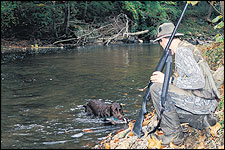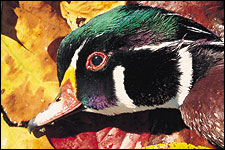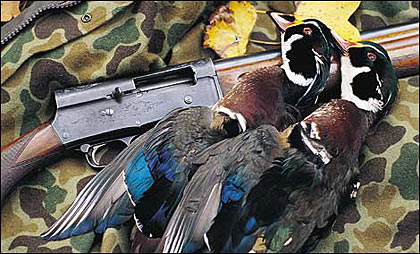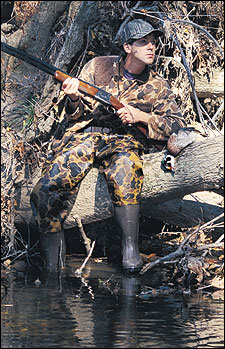November 03, 2010
By David Hart
Avoiding crowds is not easy--here's a classy way to do it.
By David Hart
 Dogs are nearly always a benefit, but very much so on brushy, free-flowing streams. |
There's nothing like the sights and sounds of a big marsh on a cold, autumn morning. Singles, pairs and even huge flocks of mallards, pintails and other puddle ducks cartwheel out of the leaden sky and drop into the decoys scattered among the cattails. With soaring duck numbers, limits often come quickly.
Unfortunately, not all of us have access to such places, particularly here in the Atlantic flyway. High-dollar leases, duck clubs and prime chunks of real estate are affordable to a select few. And the few available public hunting areas are often jammed with waterfowlers looking for--and rarely finding--their own piece of seclusion. So what's a duck hunter to do? Simple--take to the rivers and streams. Even smaller streams may be loaded with birds at some time during the fall flight. These areas offer plenty of room and are available for the asking.
Advertisement
In my home state of Virginia, waterfowlers are allowed to drop a boat into any river at public access areas, float to the ducks, nestle in behind a logjam and throw out a spread of decoys. Most states offer the same type of waterfowl hunting opportunities.
You generally won't see the variety of waterfowl you can find on larger waters. River duck hunting in the eastern part of the country starts with wood ducks. These colorful birds thrive on tree-lined, free-flowing rivers and feast on acorns and other hard mast that falls into the river from trees tilted over the water. Wild grapes and other soft mast add to their culinary choices and give woodies the varied diet they need.
Advertisement
But even early in the season, some mallards spend time on rivers. Mallards and a handful of other species occasionally drop into flowing waters and require a little more scouting than woodies. A typical bag of an early season river duck hunter here in the East is likely to bear the weight of a pair of woodies and maybe a mallard or two.
FLOAT HUNTING
One of the most effective--and easy--ways to bag a few birds is to go to them. Hunkering down among some shoreline brush works well when you find a concentration of birds, but often river ducks--particularly wood ducks--tend to find seclusion after the first half hour and stay put throughout the day, particularly if the hunting pressure has been light and the weather has been mild. That's usually the situation during the first split season. And that's why a canoe, small jonboat or even a kayak is a great way to sneak up on a flock of birds loafing along the shore on a warm, blue-sky October afternoon.
During my home state's first split season, which lasts a meager four days and opens in early October, three friends and I lash a pair of canoes to our trucks and head to one of the free-flowing rivers that cuts through the state. We take everything but the kitchen sink. Guns and other hunting equipment, fishing rods and tackle boxes, food, drinks and an extra change of clothes are all neatly arranged in our canoes. We're prepared for anything. And just like a lazy, mid-summer float-fishing trip, we park one vehicle downriver at the takeout point so we can get back upriver to the other truck at the end of the day. It's a system that works well.
 No other duck matches the drake wood duck for color. And they're hard to beat on the table, too. |
Key ingredients for a successful float-hunt are simple: Stealth, cooperation and the ability to shoot well are necessary for a full game bag. Opening-day ducks may stay put while you paddle carelessly into shooting range, but after the first few volleys on opening day, the birds wise up. That's why it's important to put some thought into your hunt, especially after the ducks have been shot at once or twice.
Typically, my partner and I simply hug the riverbank and let the current carry us to the birds. For safety's sake, the front man is the designated shooter while the guy in back keeps the Old Town pointed down river. Under no circumstances does the man in the stern keep a loaded shotgun handy--it's just too dangerous. We flip a coin to see who gets to sit up front first. After each volley of shots we pull up on a sandbar and switch places. It doesn't matter if the shooter downed a bird or not, we agree, a chance is a chance.
Where do you find the birds? River-dwelling wood ducks are bank-oriented, and mallards tend to hang out in slower sections. Most of the time, the birds will be in back waters, eddies and areas close to shore. That's where most of the food is and that's where most of the cover can be found. Logjams, fallen trees and side channels offer perfect hiding and feeding spots.
But to sneak into gun range on birds in these places requires some skill. Don't count on spotting a flock of woodies feeding along a river and then paddling into shooting range. That just isn't going to happen, except perhaps, during the first hour of opening day. Sure, you might surprise a single or pair snoozing in the shade, but try to outwit a dozen birds. Forget it. Most of the time, even opening-day ducks don't allow danger to approach too close.
Ideally, it's best to keep the boat near shore, pointed downstream, and moving at the pace of the river itself. Let the current do the work. Both hunters should keep a low profile when approaching a likely looking area, and the front man should keep his gun ready. Woodies often spring from shoreline cover without warning. Don't overlook side channels or feeder creeks, either. These smaller arteries are often bypassed by other float hunters and give ducks a break from even the lightest hunting pressure.
JUMP SHOOTING
Don't have a canoe? Can't find a second person? Don't worry, you don't always need an extra gun. One of my favorite early season tactics is to sneak along the banks of a small river and search for woodies with a pair of binoculars. I don't have to worry about filling another hunter's gamebag as well as my own, and I can stalk at my own slow pace.
Wood ducks, in particular, are notorious for loafing on tangled deadfalls and heaps of logs and debris piled up along shore. They also like to tip for acorns and other mast in slow-flowing sections of rivers. That means pockets behind logjams, fallen trees and rocky current breaks are great places to glass. But woodies are also masters at blending into such surroundings. I've learned (often the hard way) that it doesn't take much to camoflauge a small flock of these colorful ducks.
 In most eastern states, early seasons on streams means hunting wood ducks |
Like any type of hunting, stalking or still-hunting ducks requires patience, skill and practice. Don't expect ducks to spring up at your feet like a covey of quail as you stumble along the riverbank. Study the water for a hundred yards ahead of you with a quality pair of field glasses before you make a move. If you spot some birds on the water, make a good mental note of where they are and plan a route that will take you to within shooting range. The hard part is closing the wide gap between you and the ducks. A wise hunter backs off, climbs the bank and moves toward the birds out of their sight and then closes the gap with the help of shoreline brush, logs and other obstacles.
Another tactic that works incredibly well is to flush the birds to a waiting hunter. This is one of my favorite methods, and it's proven to be one of the most effective. A river my partners and I frequent is only about 30 yards wide but offers wood ducks ideal living quarters. The meandering stream flows through thick woods, borders tree-lined pastures and carves through deep, rocky gorges. Woodies thrive on it, and in the early season, before the first Canadian cold fronts arrive and push the birds south, the ducks are thick. The leaves are just starting to change colors and acorns plunk into the water from towering oaks. Tangles of wild grapes, heavy with ripe fruit, dangle over the water, tempting ducks to stretch their necks to fill their crops.
Our "flush-and-shoot" tactic really doesn't take much skill, except, perhaps, the skill of knocking down a duck winging its way upriver at breakneck speed. It's a simple technique. One of us will walk up the bank for three or four hundred yards out of sight of the water and then sneak down to an ambush point at the river's edge, while the other slogs up the middle of the stream, or stalks along the edge of the muddy bank. Loafing woodies usually spring from their resting area and fly upriver toward the waiting gun. This method offers tricky pass shooting but rarely fails to produce at least a few ducks.
On smaller rivers like the one my friends and I hunt, wood ducks seldom leave the tunnel-like river channel. Overhanging trees create a wall on either side and compel the birds to follow its course. Only ducks recently fooled by such an approach will rise above the towering trees and skirt the river channel. Mallards, on the other hand, rarely hesitate to dart through the treetops and head for distant waters. It's anybody's guess where they'll fly after they've been spooked.
HUNTING OVER DECOYS
In areas that get pushed fairly hard, it's possible to down ducks while sitting over a small decoy spread. In fact, that's one of the best ways to bag a few birds that have grown wise to float hunters. Some of the bigger rivers here in Virginia, and in most other states, have plenty of public access areas and get hunted regularly. That may make the birds wary, but it also keeps them moving throughout the day. Find a spot that they like and decoys often are the perfect tool to draw birds within gun range.
 On secluded streams blinds are not necessary--overhead cover or fallen trees make adequate blinds. |
If the thought of tossing out a spread and waiting for incoming birds is appealing, then this type of hunting is ideal. Just like a big water duck hunt, where blind and decoy placement are critical factors, hunting over blocks on a river takes some thought and preseason scouting. Remember, ducks settle into an area for a reason. If hunting pressure is high, they'll seek out a safe resting area, usually away from the main river channel.
If few waterfowlers chase ducks on your favorite river, however, then available food sources might determine the location of your setup. Either way, it's vital to go into such a situation only after you've done your homework.
On larger free-flowing rivers, hidden channels, sloughs and oxbows are relatively abundant. Here in the east, many larger waterways are broken up by large and small islands. Those side channels offer waterfowl plenty of extra places to hide from hunters floating downriver. And it offers those who want to toss out a few decoys plenty of options. Of course, picking the right spot is the hard part. It's important to remember that river ducks rarely travel in large groups, particularly in the early season. Generally, pairs, trios and small flocks are the rule. For that reason, you don't need a big spread of decoys. I sometimes bring as many as a dozen wood duck decoys but, most of the time, anywhere from four to eight will work like a charm. For added effect, as well as realism, I'll set out a pair of mallard blocks, as well. That way, when a passing flock of woodies hears the high-ball of a hen mallard from my duck call, I figure it sounds more realistic. And the occasional group of mallards or black ducks might swing to take a look at the hen calling from below.
Early season duck hunting on our free-flowing rivers offers plenty of options and plenty of birds. No, you don't have to buy into an expensive duck club, and you don't have to fork over a week's salary for a few days of guided waterfowling. Head to the nearest river, and you'll find fast, exciting action.

